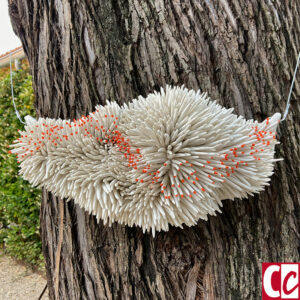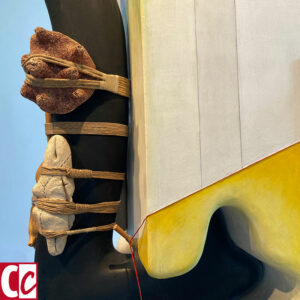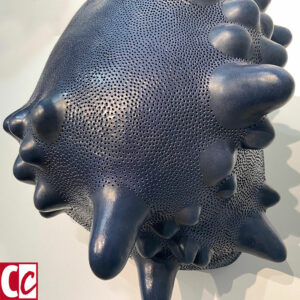
This summer I was able to rethink my criteria for reviewing ceramic art when Tom and I visited Villa Datris in France.
A themed exhibition is organized in this villa every year. To my great luck, the theme this year (2022) was ceramics. The ceramic art was grouped over 4 floors and there was also a lot of ceramic work to be seen in the garden.
Thanks to founder Danièle Kapel-Marcovici’s love for art and her altruism, the villa and its exhibition is free to enter from May to October each year. It’s a marvellous initiative and was an unexpected discovery for us.
Some of the links are affiliate links. As an affiliate associate, I earn a small commission when you purchase any of the products offered through the shared links at no extra cost to you. This helps me to maintain this website and I thank you for supporting me.
Table of Contents
Criteria for reviewing ceramic art
The same criteria we use for painting or sculpture can be used to assess ceramic art. Yet, ceramics can also be intended for use and then different criteria apply.
How to judge ceramic art?

For any art form, we have an immediate idea about it when we see it. We think it’s beautiful, or ugly, or stupid, or anything, you name it.
There’s nothing wrong with that. Although it would be a shame if that would be it and we no longer take the trouble then to really absorb the work and try to find out more about it.
Have you ever had the experience of changing your opinion of artwork when someone explained it to you? I did, and that is an enriching experience I can assure you.
However, there isn’t always someone around with background knowledge, so how do you rate a piece of ceramics?
Apart from the accompanying folder that most exhibitions have, the following aspects can give you something to hold on to.
Why was the piece made?
Already in prehistoric times, people used clay as a material to make things. And even then there was a clear distinction between utensils and artwork.
Pots were made for storage, cooking, or as a musical instrument. Figurines were sculpted to appease the gods or to enforce a favourable outcome for the hunt.
The most important criterion for a utensil is that it can be used and handled in a good and practical way. This seems obvious, but there are plenty of teapots that spill their content when pouring or pots whose lids don’t close properly.
This article is about ceramics as an art form, not about pottery, hence the other criteria focus on art.
So the question still is: why was the piece made?
Art can be a political statement or a memorial to something. It can be part of a form study or a discovery of the material and the ways in which it can be used. Try to find out why the artist created this particular work you’re looking at.
Related: Making a Ceramic Memorial: Fishing Disaster in Morecambe Bay
What are the bare facts?

Accompanying labels next to the artwork state facts like the title, the artist’s name, and the date of creation. Sometimes they also mention what materials were used and where it was made.
This information gives you an idea of, for example, the reason for the work or the art period to which a work belongs.
Type of work
The topic of the artwork can be realistic or abstract. Mixed forms are possible with most of the features I mention, so the execution can be a mix of realistic and abstract.
Look at the example of the statue of a man. Instead of a smooth skin, a structure has been applied that makes parts of the image abstract.
As a whole, it’s one of the easiest criteria to answer: What is there to see?
Which visual aspects can be distinguished?

Technique and material
Ceramics can be made on the potter’s wheel or hand-built by modelling the clay, using rolls or clay slabs.
Usually, you are not allowed to touch museum work. Too bad, because especially clay is excellent to touch.
Yet, also by just looking, you can tell whether the surface is rough or smooth. Maybe the artist has used clay with chamotte (a kind of fine ‘gravel’ that is mixed in the clay), which makes the skin lumpy.
Porcelain is a finer material than clay. Recognizable because the white of porcelain has a cooler tone than white clay.
Is the clay used purely or is it combined with other materials, such as rope, neon light, or metal?
Related: How to Make Perfect Slabs of Clay for Hand Building Ceramics

Colour
Clay comes in a few colours, of which white, red and brown are the most important. Clay can be coloured with oxides, although the colours will always be muted.
Brighter colours on ceramics will usually result from glaze, which in turn may be matte or glossy.
You can judge whether the colours are realistic and if they belong to the shape or not. Do the colours create a certain atmosphere? Were many colours used or is the work monochromatic?
Related: Ceramics in Magical Colours. How to Use the Colour of Clay Itself?
Shape
Tiles can be made from clay so a 2-dimensional representation of ceramics is possible.
We can walk around free-standing statues. I never understand why some artists gave all their attention to the front of a statue and forgot the back. It is important that the shape of each side is interesting to look at.
Relief is a form between 2-dimensional and 3-dimensional.
Have a look if the work is round, angular, organic or geometric. Is it large or small, with many or few details?
Composition
As in painting, ceramics have a certain composition. The possibilities are triangle, central, diagonal, pyramidal, symmetric or asymmetric.
Perhaps the artist used repetition or a rhythm. Do certain parts stand out or do they even fall out of tune?
Decoration
Decorating is not just painting an image on a surface. Although that is also possible on ceramics, of course.
Underglaze can be drawn or painted and even photographs can be put onto the surface as transfers.
Because clay is a flexible material as long as it has not been in the kiln, decorative elements such as notches, indentations, holes and thickenings can be applied.
Related: How to Smoke-Firing Ceramics for a Beautiful Decorative Result
Background information

The year and the place of creation can provide an indication of the social context of that time.
Also, search the internet for the title of the work or the name of the artist. What kind of other works has he or she made? Does that resemble the work you are watching?
Museums or exhibition spaces often have a reading table with background information about the participating artist and their work.
I always find it interesting to know where an artist gets inspiration from and which people or art movements have influenced them.
Final verdict
Some have no trouble at all having a judgement about art ready right away. Regularly along the lines of ‘my little brother can do that too’ or something insulting like that.
Others feel that they should never judge because they are not artists themselves.

In my opinion, both attitudes are incorrect. Someone who has taken the trouble to delve into the work and the background has every right to have an opinion.
And that can even be a negative one. After all, we do not find everything equally interesting or attractive.
Villa Datris
Both the reason for this article and the accompanying photos are from our visit to Villa Datris in France.
I can wholeheartedly recommend visiting this place if you get the chance. The focus of the summer exhibition is always different.
As a ceramist, I was of course very happy with the ceramics exhibition, but I would also have liked to have seen the one made of recycled material from 2020 or ArchiSculpture, the mixture between architecture and sculpture, in 2015.
Villa Datris, L’Isle-sur-la-Sorgue, France.
Do you like to visit exhibitions when you are on holiday? Tell me in the comment box below.




Hi Hannie,
Another inspiring ‘must see’ location on my map. The map is growing and growing.
The criteria you suggest, to judge a ceramic piece of art, are helpful. Although they represent a rather businesslike, structural type of analysis.
For me, the art I like always gives me a feeling of intimacy. It’s as if the artist shares his or her most intimate self with me. I’m not sure whether I express myself clearly.
Even background information seldomly provides such intimacy.
It’s the intimacy you feel when you visit a medieval church or convent and suddenly see a small naked man climbing a tree as a decoration of a stone pillar. The man just turns his head, looks down and gives the biggest, naughty smile I’ve ever seen.
At that specific moment, I feel closely intimate with the artist. Is it an emotional impulse? I don’t know. The art of Anish Kapoor also gives me such intimate experiences. Amazing.
Wow, what inspiring thoughts you provoke with your article!!! Compliments.
And many thanks.
Such a great way of describing your experience of art, Andrea. We are all different and I love that you can put your personal method into words.
Lovely that you are an admirer of Anish Kapoor as well! His work is fantastic. I guess you know the work of Ai Wei Wei as well, then? Such great artists and marvellous that we are able to admire their art all over the globe.
Thank you so much for your comment and have fun. 🙂
To answer your question: no, I never liked to visit exhibitions when on holiday. To say your article changed my mind is a bit of an exaggeration. Yet, it moved me to rethink my aversion. My rethinking went somewhat as follows.
I love to sit on a terrace, in front of a cafe or a restaurant, and watch the people passing by. People are colourful. They dress differently. Walk differently. Some are fat, others thin, or large and small.
People are funny to watch. And what amazes me most, watching others is very relaxing. But, and this may sound strange, when you have seen as many as I have, sometimes it is enough.
This means that on a holiday I also go out walking along the beach or cycling in the woods. I learned to enjoy botanical gardens, churches, and the like. Moreover, you can see people over there as well.
Okay, it took me some rethinking to explain myself, I probably would also enjoy exhibitions when on a holiday. For now, your article has been inspirational. My rethinking just needs a little bit of practice.
Hi Pedro, well, it would be great if my article makes you reconsider your options. 🙂
I love doing the things you mention as well, except for the cycling. But that’s because I have no bicycle and up until now never rented one. So you got me thinking about that!
I love it if inspiration works both ways. Thanks!